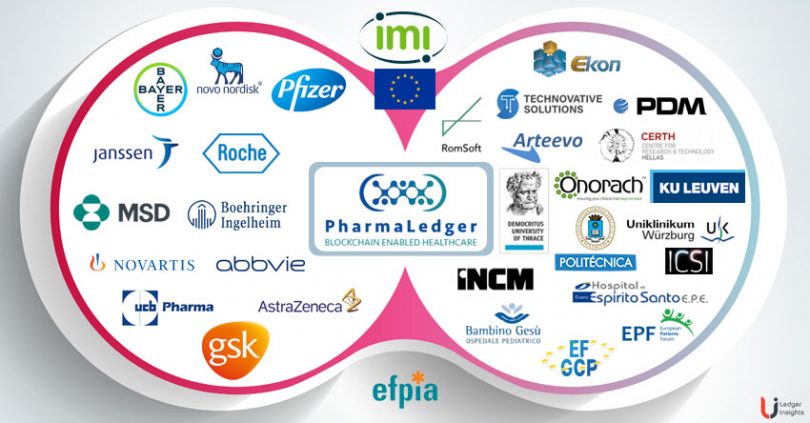Formed in January, PharmaLedger is a 29 member blockchain consortium, including 12 global pharmaceutical companies. It aims to enable healthcare innovation for supply chain, clinical trials and health data.
The initiative is a three year project sponsored by the EU-backed Innovative Medicines Initiative (IMI) and the European Federation of Pharmaceutical Industries and Associations (EFPIA) under the Horizon 2020 program. The combined budget is more than €20 million ($22m) of which a maximum of €8.33 million ($9.3m) will be contributed by the IMI. Back in August 2018, we wrote about the IMI call for proposals for “Blockchain enabled healthcare“, now known under the project title “PharmaLedger”.
Despite the focus on the three domains, PharmaLedger is keen to emphasize that the blockchain platform aims to serve any use case in the healthcare industry.
Beyond the 12 pharma companies, the other 17 participants are a mix of technology firms, hospitals, universities, research organizations, healthcare providers and patient representatives.
Novartis is the industry leader, and Novartis supply chain architect Daniel Fritz made it clear that the group’s goal isn’t just incremental efficiency gains or applications with an enhanced audit trail. “We’re aiming for transformational change. Something that creates a new capability, not just a five percent improvement on the investment.”
So given that ambition, how will they choose applications?
Filtering use cases
So far, no use cases have been selected within the three target domains, supply chain, clinical trials and health data. But Fritz shared the strategy for choosing use cases. Top of the list is patient need and the value to the industry, including health providers. That’s followed by a practicality filter.
They examine the technical complexity to see how feasible it is. But they’re also interested in the organizational and stakeholder complexity. For example, given the regulations, is it realistic? And is blockchain even the appropriate technology?
Another filter is how standalone an application is. They prefer to see something that fits in a roadmap and serves as a building block to other solutions.
“What’s really exciting about blockchain technology is that there are common patterns,” said Fritz. “And if we have this one thing in place, we can build on it without having to rebuild a whole new application. With a minor enhancement we can create completely different functions or processes, but the underlying blockchain solution or technology may be very similar. “
Technology choices
Some of the themes in PharmaLedger’s technology strategy, such as the building block approach, are familiar. Others include a desire for interoperability and plans to use APIs to integrate with a blockchain, so the application layer is relatively blockchain agnostic. And there’s a desire to address obsolescence at the planning stage.
Novartis’ Marco Cuomo commented: “In an ideal world, one could replace the (blockchain) technology without replacing the application.” But he acknowledged, in reality, it is never that simple.
The group plans to adopt a multi-chain approach. At the moment, the architecture is still at the design phase, so no decisions have been made re blockchain technologies and protocols, but they’re open to both permissioned and public blockchains.
An increasingly common pattern is to anchor permissioned blockchains to a public blockchain. That’s something in which PharmaLedger is interested. It’s harder to tamper with public blockchains because they’re usually more decentralized.
By taking a snapshot of a permissioned blockchain at a point in time and anchoring that like a fingerprint to a public blockchain, it acts as additional proof that a private blockchain has not been altered. It’s also possible to anchor specific pieces of data in a similar manner, which can also make that data more accessible to a wider audience.
As with all enterprise consortia, standards will play a vital role. To that end, HL7 International is on the PharmaLedger advisory board, which ensures that existing standards will flow into the solutions and to future governance.
Ensuring a sustainable network
Most consortia we speak with say it’s a headache to get everyone to agree on a formal structure and contracts. For PharmaLedger, it was far easier because the IMI has existing templates that have been used in more than 100 IMI projects. These templates cover intellectual property, confidentiality, voting and other issues.
Cuomo clarified there is the governance of the three-year project, and the governance of the network itself, especially beyond the initial 36-month project. This network governance is being designed at the moment. The group is also considering a decentralized autonomous organization or DAO. In other words, implementing some degree of an automated governance structure to make the network sustainable beyond the initial 36 months.
For governance to work, all the participants have to be incentivized. We also wondered about the size of the group, given large consortia tend to move slowly. Cuomo stated that this was also about incentives.
“In an ideal case, the platform is so attractive that it makes sense for them to join, whether it’s a health benefit or financial reasons or other reasons,” said Cuomo.
We also asked about the fact that it’s an EU project but includes global companies. Fritz said the industry wants to focus on regional solutions that could also scale beyond Europe in the future.
MediLedger has a DSCSA solution and has run trials with many of the group’s pharmaceutical members. In the case of Merck, it’s a participant in IBM’s PhUN network. How will that overlap be dealt with?
Fritz noted that regions such as the U.S. have a specific focus on complying with local DSCSA legislation, which is not in scope.
“We don’t want to reinvent the wheel. So we want to leverage the work that’s been done and engage with parties that have already started this journey,” said Fritz. The lines of communication are open and that openness is very much a theme for PharmaLedger.
As Dr. Pierre Meulien, IMI Executive Director, put it: “PharmaLedger brings together experts from the pharmaceutical and technology sectors as well as patients and hospitals, making it a true cross-sector, multi-disciplinary public-private partnership.”
Consortium members:
- Universidad Politécnica de Madrid (Project Coordinator) – ES
- Novartis Pharma (Industry Leader) – CH
- Projecto Desenvolvimento Manutenção Formação e Consultadoria – PT
- RomSoft – RO
- Arteevo Technologies – IL
- Technovative Solutions – UK
- EKON Modeling Software Systems– IL
- Centre for Research and Technology Hellas – GR
- AbbVie – NL
- AstraZeneca – SE
- Bayer – DE
- Boehringer-Ingelheim – DE
- GlaxoSmithKline Research and Development – UK
- Janssen Pharmaceutica – BE
- Merck Sharp & Dohme – US
- Novo Nordisk – DK
- Pfizer – UK
- F.Hoffmann-La Roche – CH
- UCB Biopharma – BE
- Katholieke Universiteit Leuven – BE
- Onorach – UK
- National Research and Development Institute for Cryogenics and Isotopic Technologies – RO
- University Hospital Würzburg – DE
- Democritus University of Thrace – GR
- Hospital do Espírito Santo de Évora – PT
- Ospedale Pediatrico Bambino Gesù – IT
- Imprensa Nacional-Casa da Moeda – PT
- European Patient Forum – BE
- European Forum for Good Clinical Practice – BE






